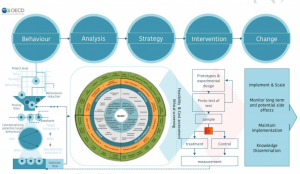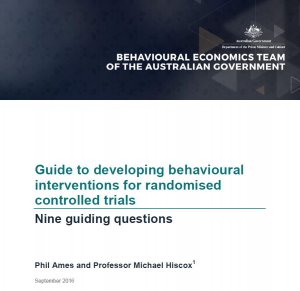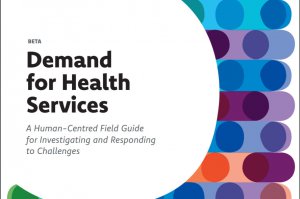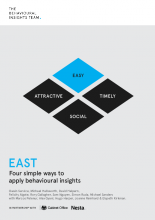Behavioural insights (BI) is an inductive approach to policy making that combines insights from psychology, cognitive science, and social science with empirically-tested results to discover how humans actually make choices.
Driven by experimentation and piloting, BI challenges established assumptions of what is thought to be rational behaviour of citizens and businesses, informing decision makers of the “actual” behaviours driving economic or societal outcomes. Behavioral economics, a related field, applies this approach to in understanding how human decisions vary from those implied in classical economics.
Basic principles
- Multi-disciplinary analysis from the behavioural sciences
- Applying the scientific method to policy making
- Empirically-tested solutions
State of the practice
Behavioural insights have become increasingly entrenched in governments around the world as a tool to improve the effectiveness of public policy. A survey of 60 ‘nudge units’ around the world and a collection of over 100 case studies on the application of behavioural insights to public policy across 11 policy domains indicates the extensive adoption of the approach. Now, over 200 institutionalised BI-related bodies exist in the public sector.
Considerations for use in the public sector
Behavioural insights can be used throughout the policy cycle to improve policy making. At the design and implementation phases, governments are using BI as a cost-effective way of testing multiple policy responses at once on a smaller scale to determine the best course of action. This limits the risk of committing resources to the full implementation of a given policy solution, which may have to be revisited at a later date. BI is also a diagnostic tool for understanding from a user perspective what works, and what does not. BI can also be used to improve the effectiveness of policy-making tools, such as debiasing the stakeholder engagement process to gain a better understanding of the true preferences of citizens. Finally, BI can also be used for changing organisational behaviour.
Typical methods and tools
Behavioural insights relies on inductive methods to test and re-test solutions before moving to full implementation, as well as to diagnose and evaluate problems, including:
- Randomised controlled trials
- Laboratory experiments
- Pilot tests
- Online experiments
- Literature reviews
Related OECD publications
Regulatory Policy and Behavioural Economics
Behavioural Insights for Public Integrity: Harnessing the Human Factor to Counter Corruption
Behavioural Insights and Public Policy: Lessons from Around the World
Behavioural Insights in Public Policy: Key Messages and Summary from OECD International Events
Protecting Consumers through Behavioural Insights: Regulating the Communications Market in Colombia
Behavioural insights and new approaches to policy design: The views from the field
See all Behavioural Insights toolkits
Would you like some help?
How well-versed are you with applying these tools and methods? Do you have experience with applying these approaches in practise? If not, then the language and complexity of the working methods can be daunting. Find help and connect to a someone who has practical experience in addressing public sector challenges. But be aware so that you do not get sucked into applying their favourite method instead of leading with your unique problem or situation.
Learn about building skills and capacity
Find OPSI network members who are working with behavioural insights
Reach out to OPSI for guidance with behavioural insights
Request a webinar on this topic – top-requested topics will be prioritised






